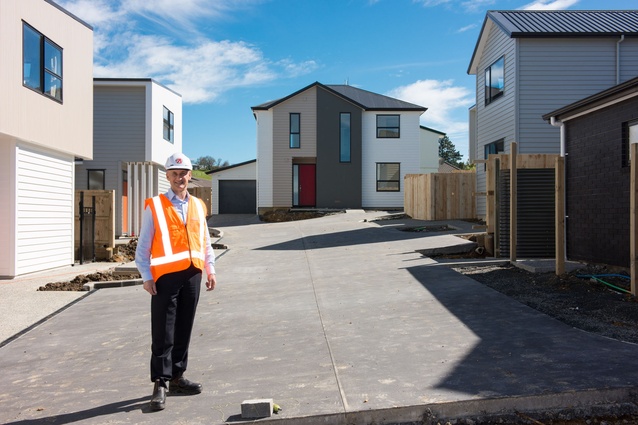The New Auckland: A radical rethink
In this series, The New Auckland, Progressive Building looks at some of the developments currently underway to house Auckland’s growing population. In this part, director of Arrow International’s Northern Branch, Graeme Birkhead, says solving Auckland’s housing crisis will require a complete overhaul of the status quo.
Auckland’s housing crisis requires more than a few extra houses; it requires a whole new way of thinking.
People have pretty short memories. Yes, we’re facing a housing crisis, but is that really surprising given we’ve hardly built any new houses since the global financial crisis broke in 2008?
If this housing crisis can teach us anything, it’s that we need to have a much, much longer-term perspective on our housing needs as well as a radical overhaul of current thinking about how we build and own houses.
Housing crises are cyclical yet there is very little planning, vision or innovation evident from leaders in this field. Successive governments and indeed many developers have responded only when we’re in a crisis, leading to higher costs, fire-fighting and inadequate planning. In short, we’re always playing catch-up.
The government, local authorities, developers, and everyone else involved in this space, need to think about what’s needed; not now, not in this term of office, but in five, 10, 15 and 20 years’ time. And they need to be planning and commissioning for it now.
We shouldn’t be building state houses or mixed private-public housing developments in the boom time. It is far too expensive for everyone involved. We should be building in the lulls, like in the seven-year lull we’ve just experienced. Planning smoothes out the bumps in the building industry’s cycles, doing away with housing crises and helping to make what we build a little more affordable.
The Australian Government is particularly good at this. In the quiet part of the building cycle they ramp up residential building subsidies to stimulate housing construction so not only are there houses being built, the prices are cheaper and the boom-bust impact is mitigated a little.
Along with better planning, more competition needs to be encouraged to reduce the cost of materials and bring fresh ideas into the industry. For example, the government’s move to temporarily drop tariffs and duties on building material imports is a good step, but it’s only temporary and it doesn’t go far enough. Accredited suppliers from overseas need to be encouraged to come to New Zealand to ensure building costs are kept down. In addition, planners, developers and builders need to think in terms of larger developments and they should be supported to do this by the central government and local authorities so they can introduce economies of scale to ensure the best possible price is achieved for all involved.
We also need to completely change the way we look at housing if we are to ensure everyone has adequate housing in the future. Land is expensive, especially in the inner-city, so we should be building more intensive and more affordable developments, including terraced housing and low-rise, mixed-size apartments as opposed to standalone houses. If you go to any of the northern beaches in Sydney for example, there are many three-storeyed brick walk-up developments, consisting of about 20 apartments, on a space equivalent to five conventional sections, and there are hundreds of these. Admittedly, these are getting a little old now, but we could easily introduce a more modern, attractive, well-designed version of these to Auckland’s suburbs.
And we need more innovation. We need to embrace new building practices to make buildings far more affordable for people to buy.
Arrow is already working with other companies to design and build modular classrooms, which will be quickly and easily added to a school when its roll expands. By producing classrooms in a factory and having large orders, we reduce production costs and introduce economies of scale, reducing supply costs. Our calculations suggest that by using this technique we can reduce building costs hugely – from $2,200 to $1,500 per square metre, while on-site construction times also drop significantly. We can also improve the quality of what we’re building, and accidents are reduced. There are many benefits to be had from introducing modular-building techniques. So why stop at classrooms?
Given the incredible advances in modular building capabilities of late, there is no reason why we can’t use this for housing. With the sophistication of modern, computer-designed manufacturing processes, prefabricated houses don’t all need to look like uniform grey boxes. Design variations are easy to achieve. Again, large orders will maximize savings, both for the buildings themselves, and for the fixtures and fittings: buying in bulk cuts costs. But being able to do so requires planning and vision.
Finally, we all need to let go of that Kiwi dream in which everyone owns a three-bedroom standalone home.
We need to adopt different practices and take the lead from successful housing models elsewhere in the world. In Europe, for example, few people ever consider owning their own home: instead, good rental properties are the norm. Here, instead of ‘ma and pa’ investors owning one or two houses and renting out the one in which they don’t reside, organisations could develop, rent and manage large mixed-housing complexes. This would ensure these rental complexes are well maintained, presented and looked after, and tenants are given far more security and length of tenure.
Industry, government and academics all need to challenge the current mindsets around housing. There is a lot to do, but a significant start would be to smooth out the boom-bust nature of the residential construction industry by stimulating construction in the down times, providing a more stable workload for the industry and lower costs down the line for all involved.
For more information on The New Auckland, click here.










